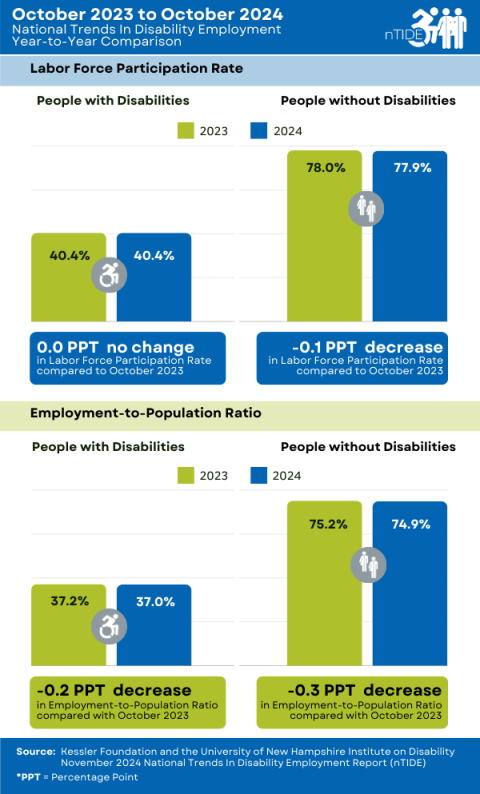
Join us for the next nTIDE Lunch & Learn Webinar featuring guest presenter Grace Caulfield from the Steven A. Cohen Military Family Clinic at Easterseals.
nTIDE November 2024 Jobs Report: Disability Employment Remains Near Historic Highs Over Past 18 Months
National Trends in Disability Employment (nTIDE) – Issued semi-monthly by Kessler Foundation and the University of New Hampshire
Durham, NH – November 1, 2024 – Following significant gains since the post-pandemic lockdown, employment rates for people with disabilities may have plateaued, remaining near historic high levels over the past 18 months despite the Federal Reserve’s efforts to slow the economy, according to today’s National Trends in Disability Employment – semi-monthly update (nTIDE) issued by Kessler Foundation and the University of New Hampshire’s Institute on Disability
Year-to-Year nTIDE Numbers (comparing October 2023 to October 2024)
The employment-to-population ratio for people with disabilities (ages 16-64) slightly decreased compared to the same month last year, from 37.2 percent in October 2023 to 37.0 percent in October 2024. For people without disabilities (ages 16-64), the employment-to-population ratio decreased slightly from 75.2 percent in October 2023 to 74.9 percent in October 2024 (down 0.3 percentage points).
The labor force participation rate for people with disabilities (ages 16-64) remained the same at 40.4 percent in October 2023 and October 2024. For people without disabilities (ages 16-64), the labor force participation rate decreased slightly from 78.0 percent in October 2023 to 77.9 percent in October 2024 (down 0.1 percentage point).

The employment-to-population ratio for people with disabilities slightly decreased compared to the same month last year, from 37.2 percent in October 2023 to 37.0 percent in October 2024. For people without disabilities, the ratio decreased slightly from 75.2 percent in October 2023 to 74.9 percent in October 2024.
“The employment-to-population ratio for people with disabilities has hovered around 37 percent over the last 18 months,” remarked John O’Neill, PhD, director of the Center for Employment and Disability Research at the Foundation. “This somewhat stable employment rate for people with disabilities is near historic highs but still reflects a 37-percentage point employment gap between people with and without disabilities,” he added.
Month-to-Month nTIDE Numbers (comparing September 2024 to October 2024)
The employment-to-population ratio for people with disabilities (ages 16-64) decreased from 37.5 percent in September 2024 to 37.0 percent in October 2024 (down 1.3 percent or 0.5 percentage points). For people without disabilities (ages 16-64), the employment-to-population ratio decreased from 75.0 percent in September 2024 to 74.9 percent in October 2024 (down 0.1 percent or 0.1 percentage points).
Meanwhile, the labor force participation rate for people with disabilities decreased from 40.8 percent in September 2024 to 40.4 percent in October 2024 (down 1.0 percent or 0.4 percentage points). For people without disabilities, the labor force participation rate remained the same at 77.9 percent in September 2024 and October 2024.

The employment-to-population ratio for people with disabilities decreased from 37.5 percent in September 2024 to 37.0 percent in October 2024. For people without disabilities, the ratio decreased from 75.0 percent in September 2024 to 74.9 percent in October 2024.
“The employment and labor force participation of people with disabilities remains strong, near historic highs, however we haven’t seen much advancement – for both people with and without disabilities – in the past 18 months,” said Andrew Houtenville, PhD, professor of economics and research director of the UNH-IOD. “This may be indicative of the Federal Reserve’s efforts to slow the economy in order to reduce inflationary pressure on prices,” he added.
In October, among workers ages 16-64, the 6,328,000 workers with disabilities represented 4.2 percent of the total 150,134,000 workers in the U.S.
Ask Questions about Disability and Employment
Each nTIDE release is followed by an nTIDE Lunch & Learn online webinar. This live broadcast, hosted via Zoom Webinar, offers attendees Q&A on the latest nTIDE findings, provides news, updates from the field, and features invited panelists who discuss current disability-related findings and events.
On November 1, 2024, at 12:00 pm – 1:00 pm Eastern, guest presenter Grace Caulfield, director of Steven A. Cohen Military Family Clinic and vice president at Easterseals will join Drs. O’Neill and Houtenville and Denise Rozell, AUCD. Attend our free Lunch & Learn live or visit the nTIDE archives at: ResearchonDisability.org/nTIDE. Also, register now for a special mid-month nTIDE Deeper Dive at nTIDE Mid-Month Deeper Dive – 11/22/2024.
